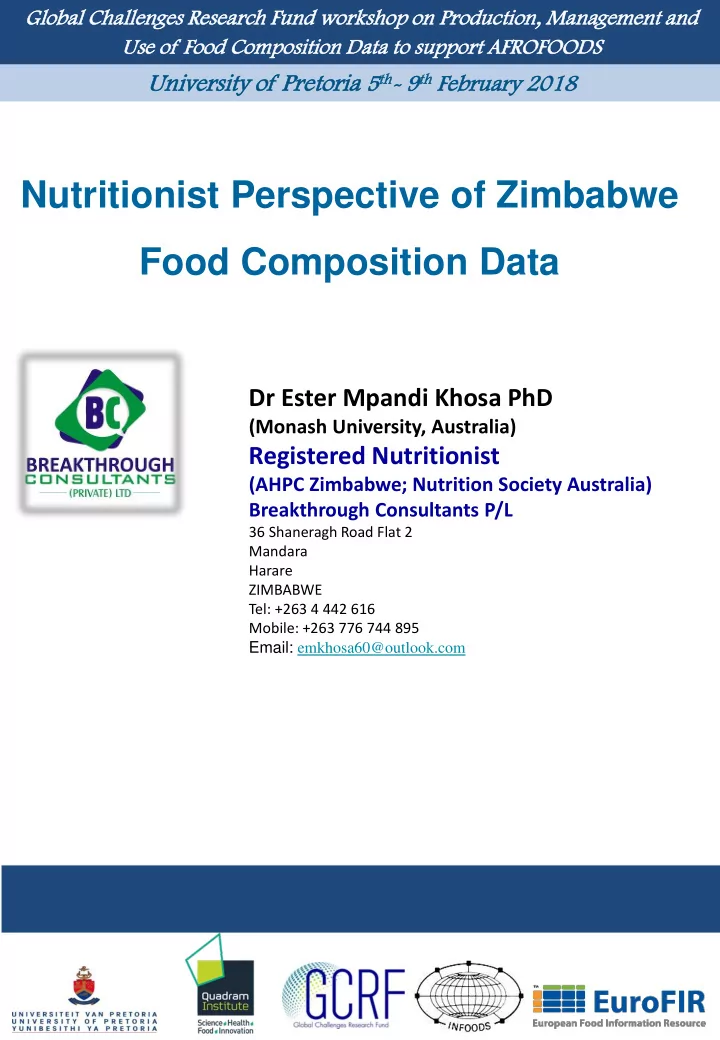

Globa bal l Challenges Resear arch Fund workshop p on P Produc duction on, Manageme ement t and Use of Food Compositio ition Data to suppor ort t AFROF OFOO OODS Univer ersi sity of Preto toria ria 5 th th - 9 th th Febr bruar uary y 2018 Nutritionist Perspective of Zimbabwe Food Composition Data Dr Ester Mpandi Khosa PhD (Monash University, Australia) Registered Nutritionist (AHPC Zimbabwe; Nutrition Society Australia) Breakthrough Consultants P/L 36 Shaneragh Road Flat 2 Mandara Harare ZIMBABWE Tel: +263 4 442 616 Mobile: +263 776 744 895 Email: emkhosa60@outlook.com
Some material in this presentation was initially made for: Australia/OCEANIAFOODS2009 February 9 - 20, 2009.
Organization Information • General information • What are the aims of your organization/department? • How are you funded? • What food composition data have you produced or published?
Current work What food composition work are you doing?Breakthrough Consultants Training Flyer.docx What foods and nutrients are you producing data for? Are you analyzing foods? Are you using data from other sources or calculating data? How is the data published?
Future plans and Challenges • Future Plans • Challenges – Analytical – Sampling – Communication – data sharing.
Outcomes Specific areas to be covered in this workshop: • Bringing Zimbabwe on-board
Justification for Zimbabwe Food Composition Data • Current data (1989) very limited and out of date • For specific Need Groups – e.g. HIV/AIDS, NCDs • Food Insecurity – imported foods and Food Aid • Food Manufacturers – nutritional labelling now mandatory • National Surveillance and surveys • Public Health Education and Awareness 7
Current Challenges • Political and economic crisis – most national activities at a stand-still • Food insecurity – eat what you get, not what you want • Whose role – R&D Centres? Universities? MHCC? Individuals? NGOs? • Shortage of skilled personnel – many Zimbabweans in the Diaspora • Limited funding (now at stand-still) • Deterioration of facilities – plans to set-up Analytical Lab at SIRDC suspended • Misconceptions on role of nutritionist – who is a nutritionist? • No knowledge of how to use Food Composition Data 8
Application of Zimbabwe Food Composition Data Zimbabwe Food Consumption Daily Food Intake 3% 3% Cereals 11% Pulses Roots & Tubers 11% Vegetables & Fruits Sugars 1% Oils 2% 67% Meat & Poultry 2% Milk, Eggs & Others Proportion of Major Foods in Daily Food Intake in a Zimbabwe Diet Adapted from: FAO/GIEWS – SADC/FSTAU (2000). Zimbabwe: Share of food consumption. 9
Zimbabwe Typical 7-Day Food Intake Day Breakfast Daytime Meal / Supper Lunch / Snack “sadza” with 1 maize porridge green boiled or with sugar and fire roasted boiled pumpkin peanut butter maize mealie leaves or sun- cobs dried vegetables in peanut butter sauce, cooked sweet potatoes or pumpkins “sadza” with beef 2 tea with sugar fruit cordial with and milk, 2 slices biscuits, fruit and green bread with vegetables margarine mixture 3 tea with sugar cordial drink rice with fried and milk and and buns cabbage and buttered bread, meat boiled egg 10
“sadza” with 4 maize porridge fermented with sugar and beverage boiled “mahewu”, peanut butter , indigenous cooked sweet indigenous vegetables or potatoes fruits from mushrooms in street venders peanut butter sauce, cooked pumpkin and maize meal pudding “sadza” with fried 5 tea with sugar carbonated and milk, buttered mineral drink cabbage, tomato bread, fried or (Fanta or Coke) and onion boiled eggs with buns “sadza” with 6 fermented maize rice and beef porridge with fermented milk, stew and sugar, peanut wild fruits, fresh legumes, fruit butter maize mealie and cooked cobs pumpkin “sadza” with 7 tea with sugar rice with cooked and milk, sweet offal meat, or pig trotters or “Kapenta” fish’, potatoes cow hooves,, dried salted roasted green ground nuts mealie cobs 11
Acknowledgement Current Sponsors: • As below In Australia: • Associate Professor Jayashree Arcot • Professor Heather Greenfield In Zimbabwe: • AHPCZ • Min. of Health and Child Care 12
References Chitsiku, I.C. (1989). Nutritive value of foods of Zimbabwe. Zambezia 16 (i), 67 – 97. English, R. & Lewis, J.(1991) Nutritional value of Australian foods. Canberra: AGPS. FAO Nutrition Country Profiles – Zimbabwe. Food and Agriculture Organization of the United Nations. http://www.fao.org/countryprofiles/index/en/?iso3=ZWE FAOSTAT Nutrition Data. Zimbabwe. http://www.fao.org/faostat/en/#country/181 2015 Nutrition country profile: Zimbabwe. INTERNATIONAL FOOD POLICY RESEARCH INSTITUTE (IFPRI) HTTP://WWW.IFPRI.ORG/PUBLICATION/2015- NUTRITION-COUNTRY-PROFILE-ZIMBABWE Gelfand, M. (1971). Diet and Tradition in an African Culture. Edinburgh. Livingstone. SAFOODS South African Food Data System (2015) http://safoods-apps.mrc.ac.za/foodcomposition/ 13
Recommend
More recommend